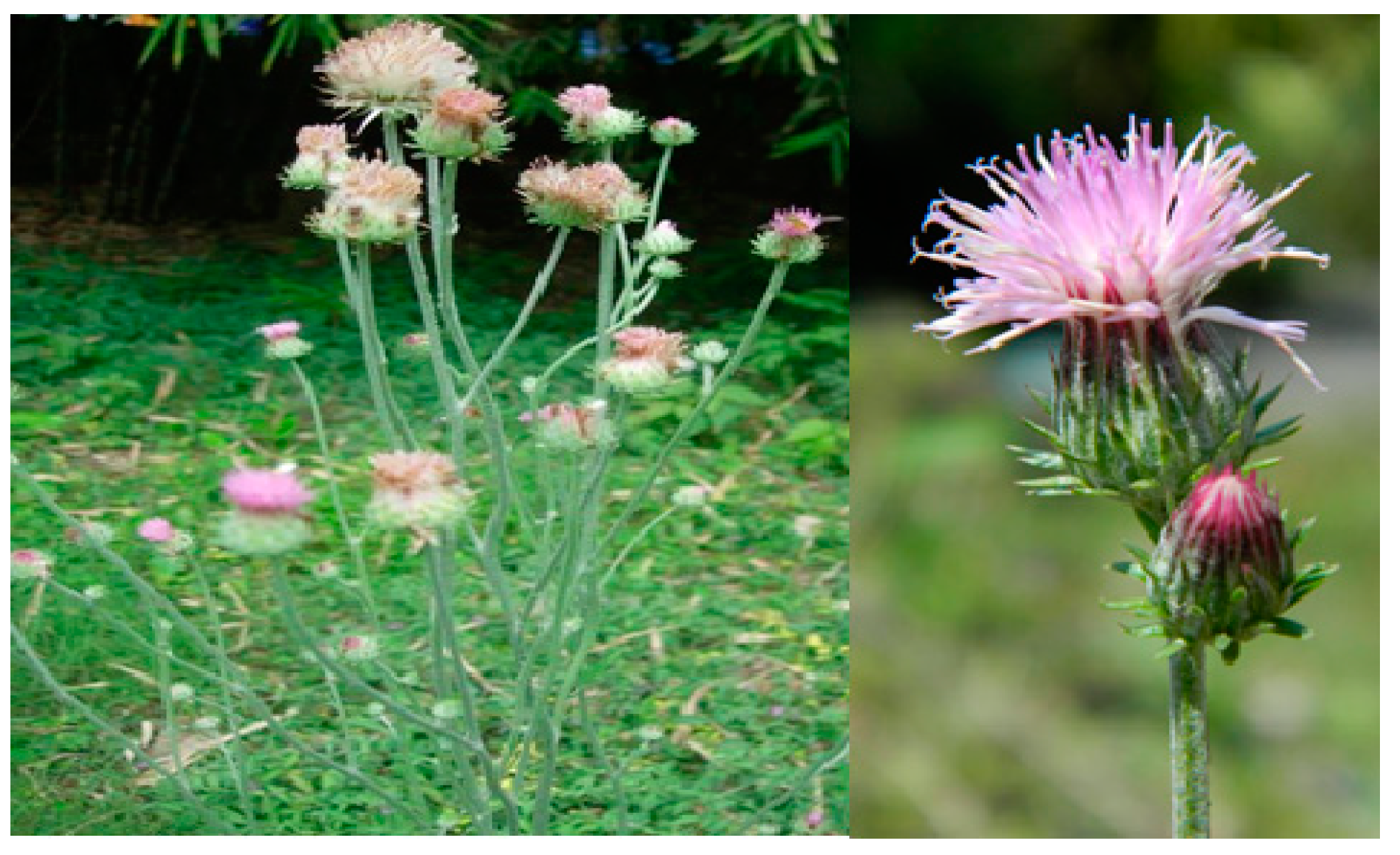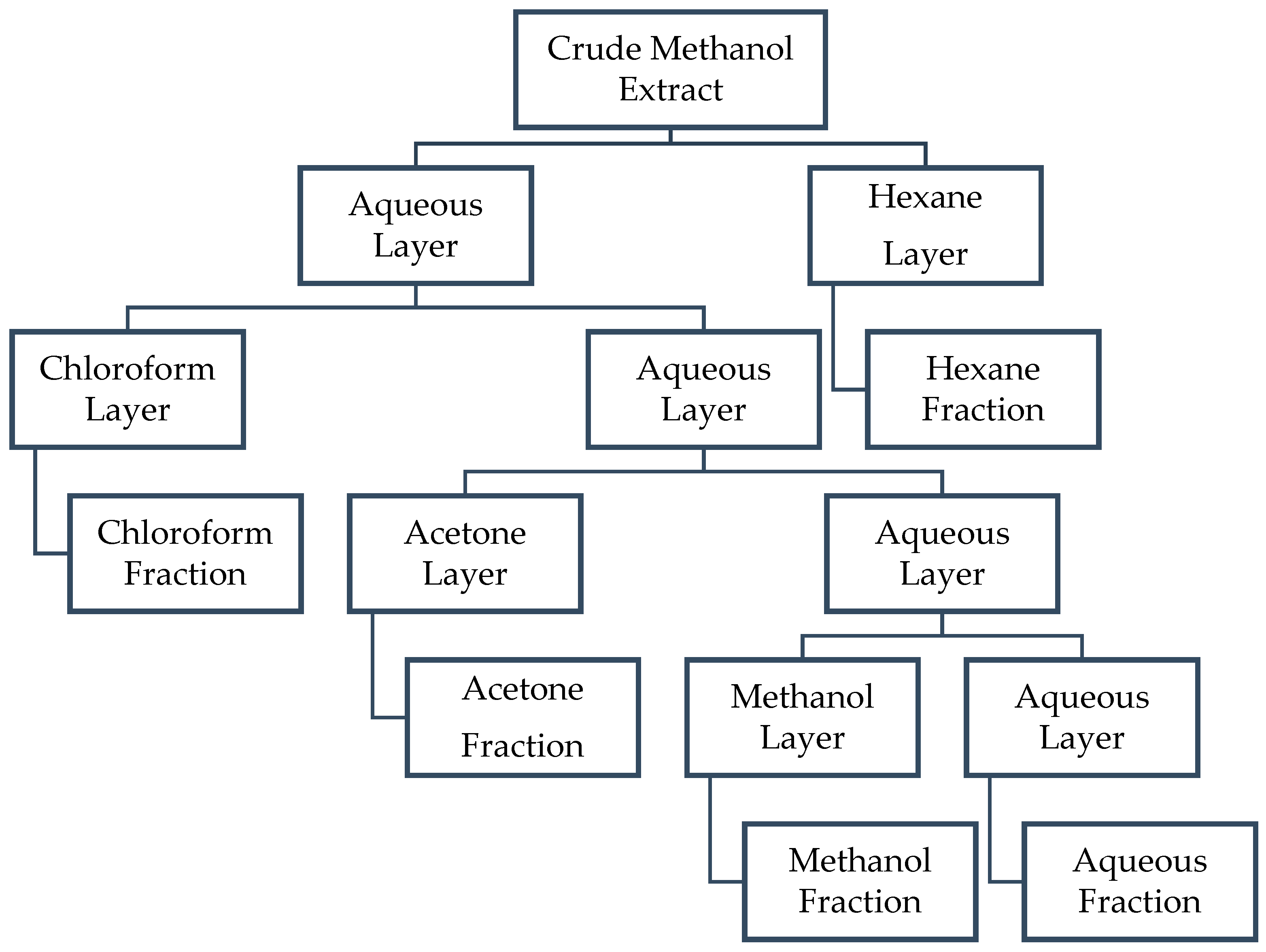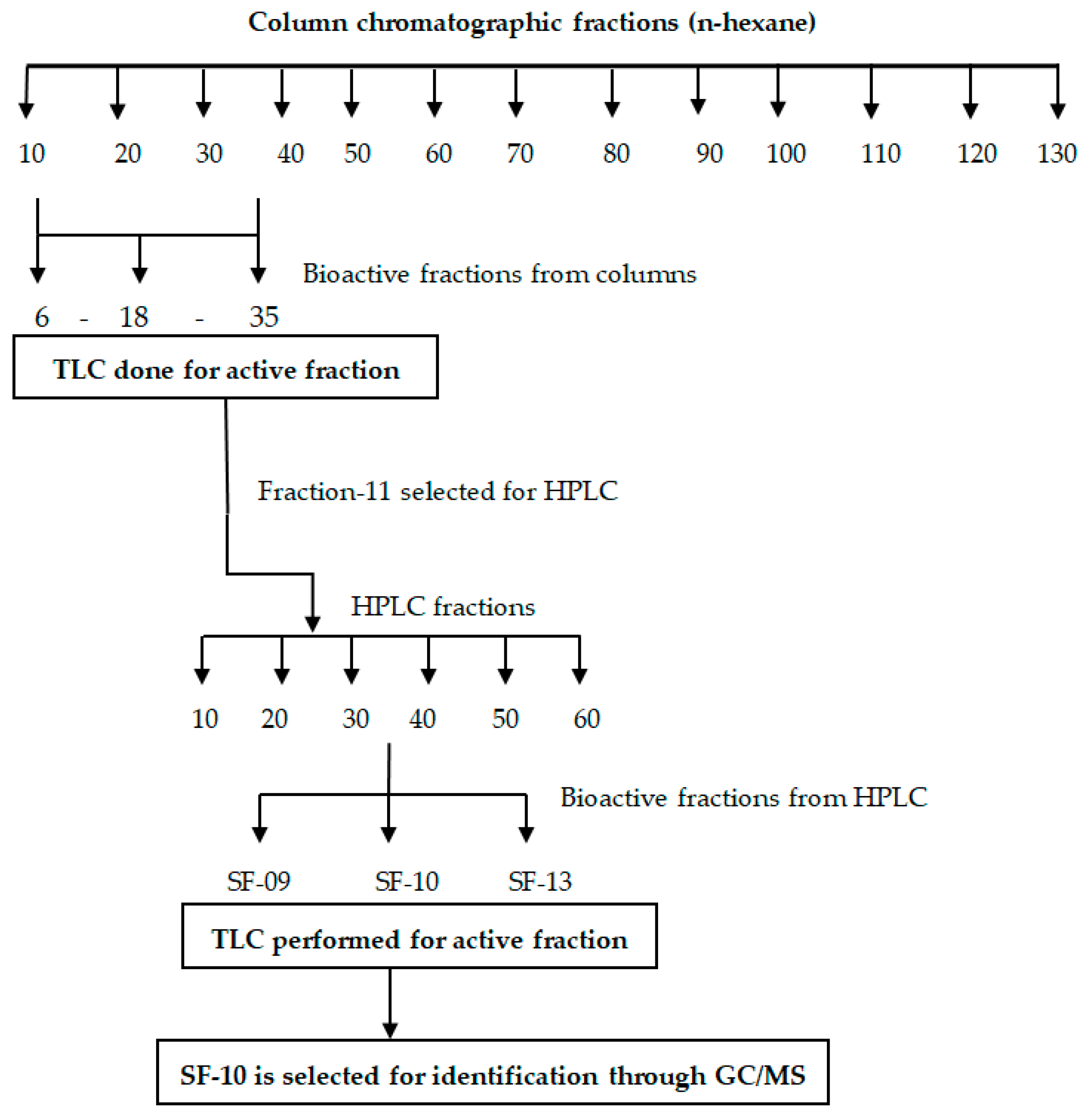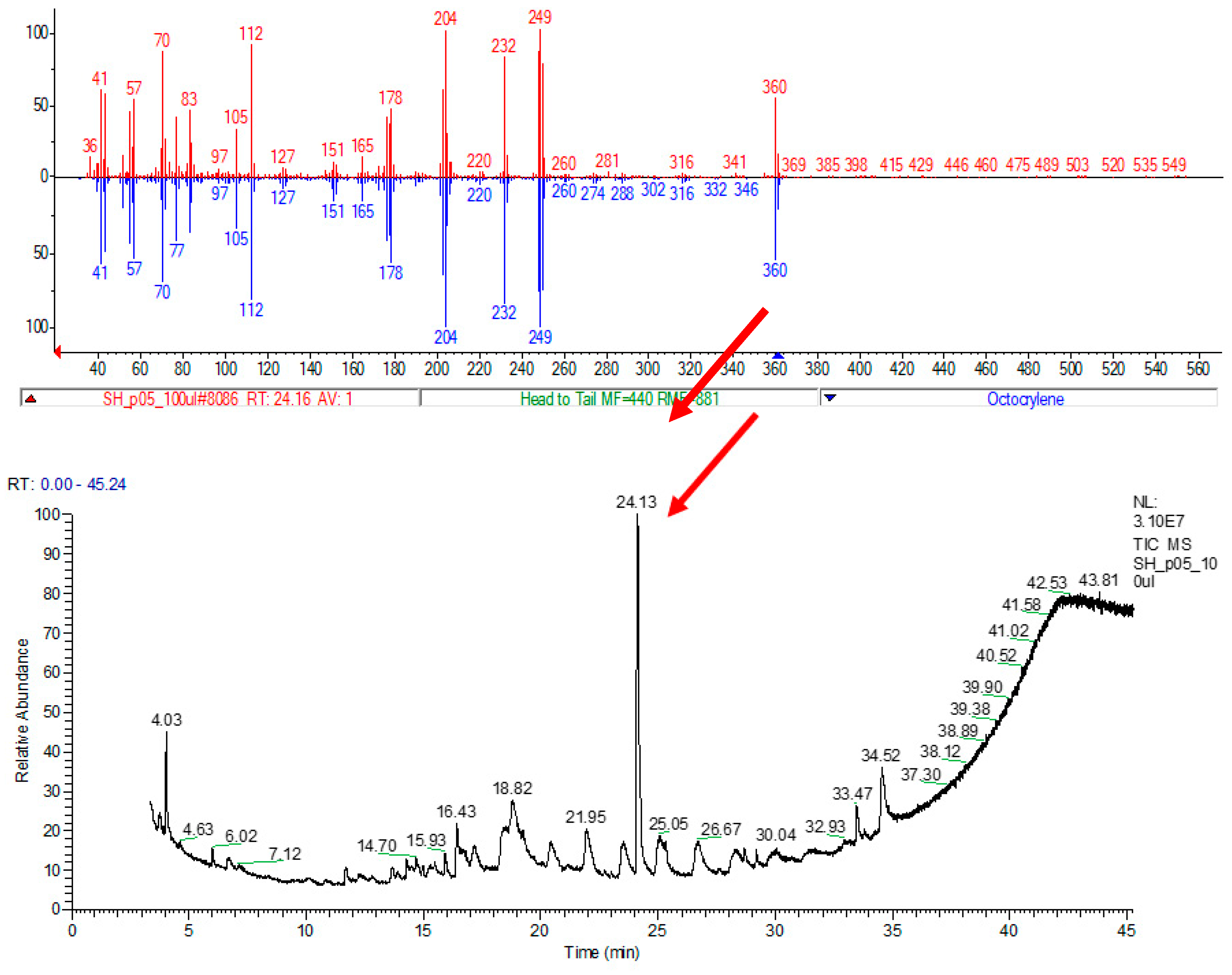Antioxidant-Activity-Guided Purification and Separation of Octocrylene from Saussurea heteromalla
Abstract
:1. Introduction
2. Materials and Methods
2.1. Collection and Identification of Plant Material
2.2. Fractionation
2.3. Free Radical Scavenging Assay
2.4. Nitric Oxide Scavenging Assay
2.5. Bioassay-Guided Purification
2.6. HPLC–DAD Analysis
2.7. GC/MS Analysis
2.8. Statistical Analysis
3. Results
3.1. Yield of Extraction
3.2. Free Radical Scavenging Assay
3.3. Nitric Oxide Scavenging Assay
3.4. Bioassay-Guided Purification
3.5. HPLC–DAD
3.6. GC/MS Analysis
4. Discussion
5. Conclusions
Supplementary Materials
Author Contributions
Funding
Institutional Review Board Statement
Informed Consent Statement
Data Availability Statement
Acknowledgments
Conflicts of Interest
References
- Altemimi, A.; Lakhssassi, N.; Baharlouei, A.; Watson, D.G.; Lightfoot, D.A. Phytochemicals: Extraction, isolation, and identification of bioactive compounds from plant extracts. Plants 2017, 6, 42. [Google Scholar] [CrossRef]
- Isman, M.B. Bioinsecticides based on plant essential oils: A short overview. Z. Naturforsch. C. 2020, 75, 179–182. [Google Scholar] [CrossRef]
- Quan, N.V.; Xuan, T.D.; Anh, L.H.; Tran, H.D. Bio-guided isolation of prospective bioactive constituents from roots of Clausena indica (Dalzell) Oliv. Molecules 2019, 24, 4442. [Google Scholar] [CrossRef]
- Basri, A.M.; Taha, H.; Ahmad, N. A review on the pharmacological activities and phytochemicals of Alpinia officinarum (Galangal) extracts derived from bioassay-guided fractionation and isolation. Pharmacogn. Rev. 2017, 11, 43. [Google Scholar] [CrossRef] [PubMed]
- Cefali, L.C.; Ataide, J.A.; Moriel, P.; Foglio, M.A.; Mazzola, P.G. Plant-based active photoprotectants for sunscreens. Int. J. Cosmet. Sci. 2016, 38, 346–353. [Google Scholar] [CrossRef] [PubMed]
- Bingol, M.N.; Bursal, E. LC-MS/MS analysis of phenolic compounds and in vitro antioxidant potential of Stachys lavandulifolia Vahl. var. brachydon Boiss. Int. Lett. Nat. Sci. 2018, 72, 28–36. [Google Scholar] [CrossRef]
- Berardesca, E.; Zuberbier, T.; Sanchez, V.M.; Marinovich, M. Review of the safety of octocrylene used as an ultraviolet filter in cosmetics. J. Eur. Acad. Dermatol. Venereol. 2019, 33, 25–33. [Google Scholar] [CrossRef] [PubMed]
- Bursal, E.; Yılmaz, M.A.; Izol, E.; Türkan, F.; Atalar, M.N.; Murahari, M.; Ahmad, M. Enzyme inhibitory function and phytochemical profile of Inula discoidea using in vitro and in silico methods. Biophys. Chem. 2021, 227, 1–14. [Google Scholar] [CrossRef]
- Ahmad, M.; Zafar, M.; Shahzadi, N.; Yaseen, G.; Murphey, T.M.; Sultana, S. Ethnobotanical importance of medicinal plants traded in herbal markets of Rawalpindi- Pakistan. J. Herb. Med. 2018, 11, 78–89. [Google Scholar] [CrossRef]
- Amjad, M.S.; Arshad, M.; Saboor, A.; Page, S.; Chaudhari, S.K. Ethnobotanical profiling of the medicinal flora of Kotli, Azad Jammu and Kashmir, Pakistan: Empirical reflections on multinomial logit specifications. Asian Pac. J. Trop. Med. 2017, 10, 503–514. [Google Scholar] [CrossRef]
- Ali, K.; Khan, N.; Rahman, I.; Khan, W.; Ali, M.; Uddin, N.; Nisar, M. The ethnobotanical domain of the Swat Valley, Pakistan. J. Ethnobiol. Ethnomed. 2018, 14, 1–15. [Google Scholar] [CrossRef]
- Rehman, K.; Mashwani, Z.R.; Khan, M.A.; Ullah, Z.; Chaudhary, H.J. An ethnobotanical perspective of traditional medicinal plants from the Khattak tribe of Chonthra Karak, Pakistan. J. Ethnopharmacol. 2015, 165, 251–259. [Google Scholar] [CrossRef] [PubMed]
- Shah, A.A.; Khan, Z.; Ramzan, M.; Saba, R. Ethnoecological studies of herbs and shrubs of Miani Sahib Graveyard, Lahore city, Punjab, Pakistan. J. Bioresour. Manag. 2016, 3, 33–34. [Google Scholar] [CrossRef]
- Saboon; Arshad, M.; Bibi, Y.; Ahmad, M.S. Multi-elemental analysis of some traditional medicinal plants from Marghalla Hill National Park, Pakistan. J. Pure Appl. Agric. 2022, 7, 29–42. [Google Scholar]
- Adebayo, S.A.; Ondua, M.; Shai, L.J.; Lebelo, S.L. Inhibition of nitric oxide production and free radical scavenging activities of four South African medicinal plants. J. Inflamm. Res. 2019, 12, 195. [Google Scholar] [CrossRef] [PubMed]
- Kerkoub, N.; Panda, S.K.; Yang, M.R.; Lu, J.G.; Jiang, Z.H.; Nasri, H.; Luyten, W. Bioassay-guided isolation of anti-candida biofilm compounds from methanol extracts of the aerial parts of Salvia officinalis (Annaba, Algeria). Front. Pharmacol. 2018, 9, 1418. [Google Scholar] [CrossRef]
- Bajpai, V.K.; Majumder, R.; Park, J.G. Isolation and purification of plant secondary metabolites using column-chromatographic technique. Bangladesh J. Pharmacol. 2016, 11, 844–848. [Google Scholar] [CrossRef]
- Khalil, R.; Ali, Q.; Hafeez, M.; Malik, A. Phenolic acid profiling by RP-HPLC: Evaluation of antibacterial and anticancer activities of Conocarpus erectus plant extracts. Biol. Clin. Sci. Res. J. 2020, 1, 45–46. [Google Scholar] [CrossRef]
- Yosri, M.; Amin, B.H.; Abed, N.N.; Elithy, A.S.; Kareem, S.M.; Sidkey, N.M. Identification of novel bioactive compound derived from Rheum officinalis against campylobacter jejuni NCTC11168. Sci. World J. 2020, 20, 1–9. [Google Scholar] [CrossRef]
- Colpo, E.; Vilanova, C.D.D.; Reetz, L.G.B.; Duarte, M.M.; Farias, I.L.G.; Meinerz, D.F.; Rocha, J.B.T. Brazilian nut consumption by healthy volunteers improves inflammatory parameters. Nutrition 2014, 30, 459–465. [Google Scholar] [CrossRef]
- Barbosa, F.V.M.; Waczuk, E.P.; Kamdem, J.P.; Abolaji, A.O.; Lacerda, S.R.; Costa, J.G.M.; Posser, T. Phytochemical constituents, antioxidant activity, cytotoxicity and osmotic fragility effects of Caju (Anacardium microcarpum). Ind. Crops Prod. 2014, 55, 280–288. [Google Scholar] [CrossRef]
- Batool, A.; Miana, G.A.; Muddassir, M.; Khan, M.A.; Zafar, S. In vitro cytotoxic, antioxidant, antibacterial and antifungal activity of Saussurea heteromalla indigenous to Pakistan. Pak. J. Pharm. Sci. 2019, 32, 2771–2777. [Google Scholar] [CrossRef]
- Batool, A.; Miana, G.A.; Alam, M.; Khan, M.T.; Muddassir, M.; Zaman, W.; Khan, S.; Aman, A.; Khusro, A.; Arasu, M.V.; et al. Bioassay-guided fractionation and isolation of Arctigenin from Saussurea heteromalla for in vitro and in silico cytotoxic activity against HeLa cells. Physiol. Mol. Plant Pathol. 2022, 117, 101749. [Google Scholar] [CrossRef]
- Saboon; Arshad, M.; Ahmad, M.S.; Mashwani, Z.R. Fermentation Enhances Redox Protective Activities of Gymnosporia royleana Wall. ex Lawson Extracts. Iran. J. Sci. Technol. Trans. A: Sci. 2019, 43, 15–23. [Google Scholar] [CrossRef]
- Saklani, A.; Hegde, B.; Mishra, P.; Singh, R.; Mendon, M.; Chakrabarty, D.; Kulkarni-Almeida, A.A. NF-κB dependent anti-inflammatory activity of chlorojanerin isolated from Saussurea heteromalla. Phytomedicine 2012, 19, 988–997. [Google Scholar] [CrossRef]
- Henke, M.T.; Kelleher, N.L. Modern mass spectrometry for synthetic biology and structure-based discovery of natural products. Nat. Prod. Rep. 2016, 33, 942–950. [Google Scholar] [CrossRef]
- Zhao, J.; Zhao, Y.; Hu, C.; Zhao, C.; Zhang, J.; Li, L.; Xu, G. Metabolic profiling with gas chromatography–mass spectrometry and capillary electrophoresis–mass spectrometry reveals the carbon–nitrogen status of tobacco leaves across different planting areas. J. Proteome Res. 2016, 15, 468–476. [Google Scholar] [CrossRef] [PubMed]
- Zhao, T.; Li, S.J.; Zhang, Z.X.; Zhang, M.L.; Shi, Q.W.; Gu, Y.C.; Dong, M.; Kiyota, H. Chemical constituents from the genus Saussurea and their biological activities. Heterocycl. Comm. 2017, 23, 331–358. [Google Scholar] [CrossRef]
- Chunsriimyatav, G.; Hoza, I.; Valášek, P.; Skrovanková, S.; Banzragch, D.; Tsevegsuren, N. Determination of Phenolic compounds in Saussurea salicifolia (L.) DC. by HPLC. Czech J. Food Sci. 2009, 27, 259–261. [Google Scholar] [CrossRef]
- Seilgazy, M.; Li, J.; Aisa, H.A. Isolation of steroidal esters from seeds of Saussurea involucrata. Chem. Nat. Compd. 2017, 53, 1196–1198. [Google Scholar] [CrossRef]
- Astuti, R.I.; Prastya, M.E.; Batubara, I.; Budiarti, E.; Ilmiyawati, A. Antiaging and antioxidant bioactivities of asteraceae plant fractions on the cellular functions of the Yeast Schizosaccharomyces pombe. Adv. Pharmacol. Pharmaceut. Sci. 2021, 2021, 2119634. [Google Scholar] [CrossRef] [PubMed]
- Zhong, X.; Downs, C.A.; Li, Y.; Zhang, Z.; Li, Y.; Liu, B.; Li, Q. Comparison of toxicological effects of oxybenzone, avobenzone, octocrylene, and octinoxate sunscreen ingredients on cucumber plants (Cucumis sativus L. ). Sci. Total Environ. 2020, 714, 136879. [Google Scholar] [CrossRef] [PubMed]
- Asraoui, F.; Kounnoun, A.; Cadi, H.E.; Cacciola, F.; Majdoub, Y.O.E.; Alibrando, F.; Mandolfino, F.; Dugo, P.; Mondello, L.; Louajri, A. Phytochemical investigation and antioxidant activity of Globularia alypum L. Molecules 2021, 26, 759. [Google Scholar] [CrossRef] [PubMed]





| Solvents | Yield (%) |
|---|---|
| Hexane | 2.13 |
| Chloroform | 1.80 |
| Acetone | 2.90 |
| Methanol | 4.30 |
| Aqueous | 5.70 |
| Solvent | Concentration μg/mL | IC50 | ||||
|---|---|---|---|---|---|---|
| 1000 | 500 | 250 | 125 | 62.5 | ||
| Methanol | 79.76 ± 0.41 | 68.30 ± 0.82 | 56.57 ± 0.53 | 42.23 ± 0.64 | 31.20 ± 1.73 | 224.02 ± 2.67 |
| Acetone | 75.06 ± 0.79 | 64.23 ± 1.26 | 47.86 ± 0.9 | 32.40 ± 0.57 | 25.36 ± 0.73 | 288.92 ± 1.58 |
| Chloroform | 83.43 ± 0.48 | 73.98 ± 0.73 | 57.26 ± 0.51 | 51.00 ± 0.02 | 30.49 ± 0.26 | 174.88 ± 1.97 |
| n-Hexane | 96.60 ± 2.31 | 85.03 ± 1.72 | 65.93 ± 0.86 | 51.27 ± 2.41 | 32.16 ± 1.04 | 102.56 ± 4.48 |
| Water | 66.50 ± 1.43 | 53.56 ± 0.57 | 44.93 ± 0.94 | 30.90 ± 0.43 | 23.83 ± 0.25 | 434.33 ± 2.48 |
| Solvent | Concentration μg/mL | IC50 | ||||
|---|---|---|---|---|---|---|
| 1000 | 500 | 250 | 125 | 62.5 | ||
| Methanol | 70.4 ± 0.24 | 65.3 ± 0.45 | 52.7 ± 0.19 | 47.5 ± 0.14 | 40.4 ± 0.25 | 187.66 ± 1.34 |
| Acetone | 80.9 ± 0.63 | 76.5 ± 0.12 | 63.9 ± 0.28 | 53.8 ± 0.07 | 37.4 ± 0.09 | 114.84 ± 0.94 |
| Chloroform | 80.4 ± 0.04 | 68.6 ± 0.01 | 63.5 ± 0.31 | 51.0 ± 0.02 | 44.7 ± 0.05 | 289.99 ±1.39 |
| n-Hexane | 87.5 ± 0.30 | 80.6 ± 0.23 | 75.5 ± 0.19 | 64.8 ± 0.15 | 50.3 ± 0.15 | 61.67 ± 1.73 |
| Water | 67.4 ± 0.32 | 63.8 ± 0.05 | 48.3 ± 0.13 | 34.9 ± 0.26 | 31.8 ±0.06 | 262.35 ± 1.28 |
| Compounds | DPPH Scavenging Ability | NO Inhibition (%) |
|---|---|---|
| Octocrylene | 95.31 ± 0.32 | 91.48 ± 0.75 |
| Quercetin | 98.17 ± 0.07 | 94.63 ± 0.03 |
Disclaimer/Publisher’s Note: The statements, opinions and data contained in all publications are solely those of the individual author(s) and contributor(s) and not of MDPI and/or the editor(s). MDPI and/or the editor(s) disclaim responsibility for any injury to people or property resulting from any ideas, methods, instructions or products referred to in the content. |
© 2023 by the authors. Licensee MDPI, Basel, Switzerland. This article is an open access article distributed under the terms and conditions of the Creative Commons Attribution (CC BY) license (https://creativecommons.org/licenses/by/4.0/).
Share and Cite
Saboon; Bibi, Y.; Ayoubi, S.A.; Afzal, T.; Gilani, S.; Malik, K.; Qayyum, A.; Hussain, M.; Kumar, S. Antioxidant-Activity-Guided Purification and Separation of Octocrylene from Saussurea heteromalla. Separations 2023, 10, 107. https://doi.org/10.3390/separations10020107
Saboon, Bibi Y, Ayoubi SA, Afzal T, Gilani S, Malik K, Qayyum A, Hussain M, Kumar S. Antioxidant-Activity-Guided Purification and Separation of Octocrylene from Saussurea heteromalla. Separations. 2023; 10(2):107. https://doi.org/10.3390/separations10020107
Chicago/Turabian StyleSaboon, Yamin Bibi, Samha Al Ayoubi, Tayyiba Afzal, Sobia Gilani, Khafsa Malik, Abdul Qayyum, Mubashar Hussain, and Sunjeet Kumar. 2023. "Antioxidant-Activity-Guided Purification and Separation of Octocrylene from Saussurea heteromalla" Separations 10, no. 2: 107. https://doi.org/10.3390/separations10020107
APA StyleSaboon, Bibi, Y., Ayoubi, S. A., Afzal, T., Gilani, S., Malik, K., Qayyum, A., Hussain, M., & Kumar, S. (2023). Antioxidant-Activity-Guided Purification and Separation of Octocrylene from Saussurea heteromalla. Separations, 10(2), 107. https://doi.org/10.3390/separations10020107








